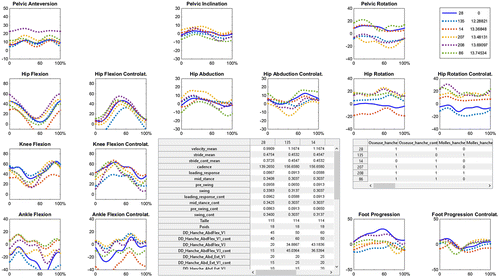1. Introduction
Orthopedic surgery is usually performed in order to lessen gait abnormalities observed on cerebral palsy (CP) patients. Multiple bones and muscles are modified during a Single Event Multilevel Surgery (SEMLS) (Gage et al., Citation2009), which combines several surgical procedures in the same operation. In general, surgical treatment decision is based on physical examination and Clinical Gait Analysis (CGA). If some decision-making process based on objective data are clearly defined, the clinician’s experience remains decisive in planning a ‘tailor-made’ single event multilevel surgery (SEMLS). However, if experience may be usefull, its reliability is not absolute, and may be affected by multiple non-specific factors. Therefore modelling clinical experience may improve its reliability. The purpose of this work is to assess if it is possible to develop an objective tool for comparing the patient to be operated with those that have already been operated.
2. Methods
This retrospective study analyzed anonymous data of N CP children that have undergone SEMLS since 2004. These children have had physical examination and CGA before and at least one year after surgery. Lower limb marker placements were identical and kinematic data were computed with the same software based on a modified Helen Hayes (Davis III et al., Citation1991; Kadaba et al., Citation1990) model with anatomical markers on the femoral condyles and the medial-malleolus.
Fifteen kinematic angles were considered for each patient: pelvic tilt, pelvic obliquity, pelvic rotation and hip flexion, hip adduction, hip rotation, knee flexion, ankle dorsiflexion and foot progression for both lower limbs. Those kinematic signals were dimensionally reduced in 186 variables by Fourier series. Were also considered, 12 Spatio-temporal parameters and 36 clinical examination data (including information about size and weight; hip, knee and ankle ranges of motion; muscle force; and spasticity).
For each patient, his closest neighbors are searched by a k-nearest neighbor algorithm based on this 234 parameters vector (Friedman et al., Citation1977). Two options are therefore possible:
| • | the analytical study of the surgeries and of the postoperative results of the nearest neighbors; | ||||
| • | the prediction of the probable kinematic outcome of the patient under consideration. The latter is, if possible, calculated by the mean of the postoperative results of the k closest neighbors with a preoperative distance less than X points of ‘Gait Profile Score’ (GPS) (Baker et al., Citation2009) and having had surgery equivalent to that planned. | ||||
The performance of this second option is evaluated by leave-one-out by the calculation of GVS and GPS between predicted and true outcome. The effects of k and X are tested on the matching and prediction performance.
3. Results and discussion
N = 141 children with PC were included. 41 patients had a Gross Motor Function Classification System (GMFCS) level I, 70 a level II and 30 a level III. Male subjects represent 61% of the population and 39% are female. The mean ages of patients are 11.9 y/o (SD = 3.3) and 14.9 y/o (SD = 3.3) for preoperative and postoperative CGA respectively. The k-nearest neighbor algorithm is efficient at finding the most similar patients compared to the tested one as can be seen on Figure . Concerning the second option of the system, the combination of k = 20 and X = 10° allows optimal postoperative prediction for 25 patients with an average ‘GPS’ prediction error (standard deviation) of 8.3° (1.6°). For each joint angles the ‘GVS error’ are given by Table .
Figure 1. Nearest patients to the tested one. The system gives the bilateral 3D kinematics (in the different subplots), the physical examination parameters and the surgical program (in the two tables) realized on the nearest patients (IDs: 135, 14, 207, 208, 86,...) to the tested one (ID: 28) plotted in plain blue. The clinician may therefore compare the kinematic curves of the studied patient to his nearest counterparts for each joints.

Table 1. Root mean square prediction errors in degree for the different kinematic parameters.
4. Conclusions
The system is able to present the surgeries performed and their associated results for all the patients closest to the patient being tested. In cases where the intended surgical strategy has already been performed on similar patients, an estimate of the possible outcome of surgery is generated. This relatively rudimentary system has the advantage of being very robust and places the clinician at the heart of his clinical experience.
Acknowledgements
This work is part of the SIM-PC2 project funded by Région Ile de France, Fondation Ellen Poidatz and Fondation Bettencourt Schueller. The authors are grateful to the medical and technical staff of Fondation Ellen Poidatz for useful discussions and for recording the data used for this work.
References
- Baker R., McGinley J.L., Schwartz M.H., Beynon S., Rozumalski A., Graham H.K., Tirosh O., 2009. The Gait Profile Score and Movement Analysis Profile. Gait Posture. 30, 265–269.10.1016/j.gaitpost.2009.05.020
- Davis, III, R.B., Õunpuu, S., Tyburski, D., Gage, J.R., 1991. A gait analysis data collection and reduction technique. Hum. Mov. Sci. 10, 575–587.10.1016/0167-9457(91)90046-Z
- Friedman, J.H., Bentley, J.L., Finkel, R.A., 1977. An Algorithm for Finding Best Matches in Logarithmic Expected Time. ACM Trans Math Softw 3, 209–226.10.1145/355744.355745
- Gage, J.R., Schwartz, M.H., Koop, S.E., Novacheck, T.F., 2009. The Identification and Treatment of Gait Problems in Cerebral Palsy, 2nd. Edition ed. MacKeith Press, London.
- Kadaba, M.P., Ramakrishnan, H.K., Wootten, M.E., others, 1990. Measurement of lower extremity kinematics during level walking. J. Orthop. Res. 8, 383–392.10.1002/(ISSN)1554-527X
